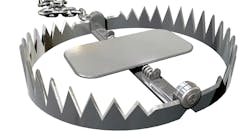Raise your hand if you have a significant amount of dollars ($400,000 or more) in a profit-sharing plan, IRA, 401(k) or other qualified plan. Got your hand up? You are in a tax trap. Sorry, but you must pay at least one tax... maybe a double tax. This column explains the horrible tax rules and how to turn the double tax into tax-free dollars.
An example is the best way to explain this crazy area of the tax law. Following is the story of a reader of this column (Jack). He owns a closely held business. After a planning meeting with his professionals (attorney and CPA), both agreed that Jack's family would receive about only $540,000 out of the $1.5 million he had in his IRA. About $960,000 (64 percent) would be lost to the IRS. Neither professional had a clue of how to avoid this huge tax loss. Sad!
You'll want to learn what Jack did to escape the tax trap. Chances are you will want to use the same (or a variation) tax strategy he used.
Now Jack's story: He and his wife Jill are both 63 years old, in the highest income tax bracket (40 percent, combining Federal and state taxes) and highest estate tax bracket (currently 40 percent). Jack hates to pay taxes... would like to get the full $1.5 million (or whatever amount the IRA may grow to), to his children and grandchildren.
There are many strategies — in real-life practice — that will help the Jacks of the world, but let's explore the one we use the most. Interestingly enough, this strategy — called "Retirement Plan Rescue" (RPR) — can help almost anybody (especially business owners) in a high income tax and estate bracket.
Here’s what Jack did first. He rolled the funds ($600,000) in his 401(k) plan into his IRA. The IRA now had a total of $2.1 million.
A little side note: Jack knows that every dollar in the IRA (the result would be the same with his 401(k) plan) will be double taxed. About 36 cents of every dollar to his family: an outrageous 64 cents to the IRS and his state of residence. If Jack and Jill got hit by the same bus, the tax collectors would get $1,344,000 of their $2.1 million. A tax tragedy!
Instead, following is the two-step strategy that Jack and Jill — with the help of my professional network — implemented.
Step 1: They purchased a $4.2 million second-to-die insurance policy (actually owned by an irrevocable life insurance trust, which will keep every dollar of the insurance benefit tax-free for estate tax purposes). Now, their family is guaranteed to receive the entire $4.2 million. If you are curious, the $2.1 million IRA would have to grow to about $11.7 million to net the family the same $4.2 million. Yes, the double tax bite would be an unbelievable $7.5 million.
The policy’s premiums ($64,218 per year) are paid by Jack, after withdrawing the funds ($107,030) from the IRA and paying the income tax ($42,812) on the withdrawal. The next question is, “How are we assured there will be enough funds in the IRA to pay the premiums each year?” We are now ready for Step 2.
Step 2: Jack has the $2.1 million IRA funds invested in a diversified basket of annuities, bonds and preferred stocks that net him 4.25% of income per year. That’s plenty of income, together with the IRA principal, to pay the required premiums way beyond the life expectancy of Jack and Jill. Actually, he could have purchased $6 million (plus) of insurance, but conservative Jack was concerned about some of his investments maturing and the future income rates of return going down. Caution: Step 2 should be a conservative calculation (done by a professional) to make sure there will be enough funds to pay the premiums for the rest of your life.
Here’s a hint: As a practical matter, you can always adjust the death benefit down (never up) and lower the premiums accordingly to keep the policy in force.
It should be noted that we have used the RPR strategy for about 75 clients over the years from as young as 44 to as old as 82. About half insured a single life and the other half (like Jack and Jill) were second-to-die. As long as your health allows you to acquire the insurance, the numbers always turn the potential double tax into a tax-free (money making) victory.
Finally, it should be pointed out that an RPR is very flexible. About 30% of the people who implement the strategy only use a portion of their IRA funds to increase their heirs' inheritance at the expense of the IRS, with the intent of using the balance for their retirement. A terrific tax plan!
Even more interesting, about 20% of the folks who use the strategy use other funds to pay the tax on their IRA distributions and maximize the wealth (via more insurance) their family will receive. Neat!
The RPR is the brainchild of some lawyers in my national tax network. Want to learn more about how a RPR (there are many variations) will turn your potential 64 percent tax loss into millions of dollars of after-tax dollars? Here’s what you do: Fax to 847/674-5299 your name, birthday, address and phone numbers (home, business, cell). Include your spouse’s birthday, if you are married. Include the total amount in all of your qualified plans (IRA/401(k)/etc.). Mark “RPR” at the top of the page.
Irv Blackman, CPA and lawyer, is a retired partner of Blackman Kallick LLP and chairman emeritus of the New Century Bank, both in Chicago. He can be reached at 847/674-5295, e-mail [email protected], or on the Web at: www.taxsecretsofthewealthy.com.


